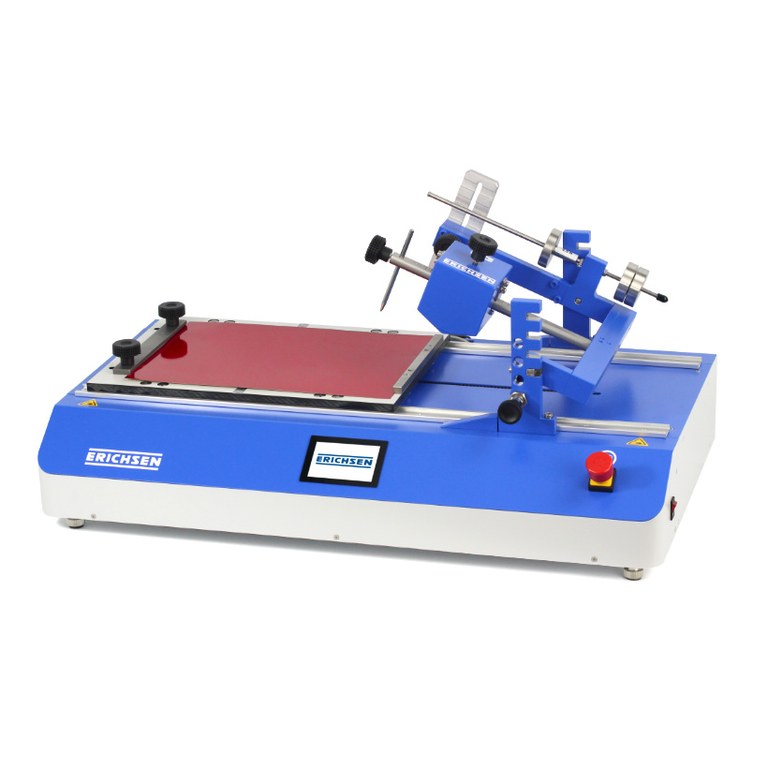
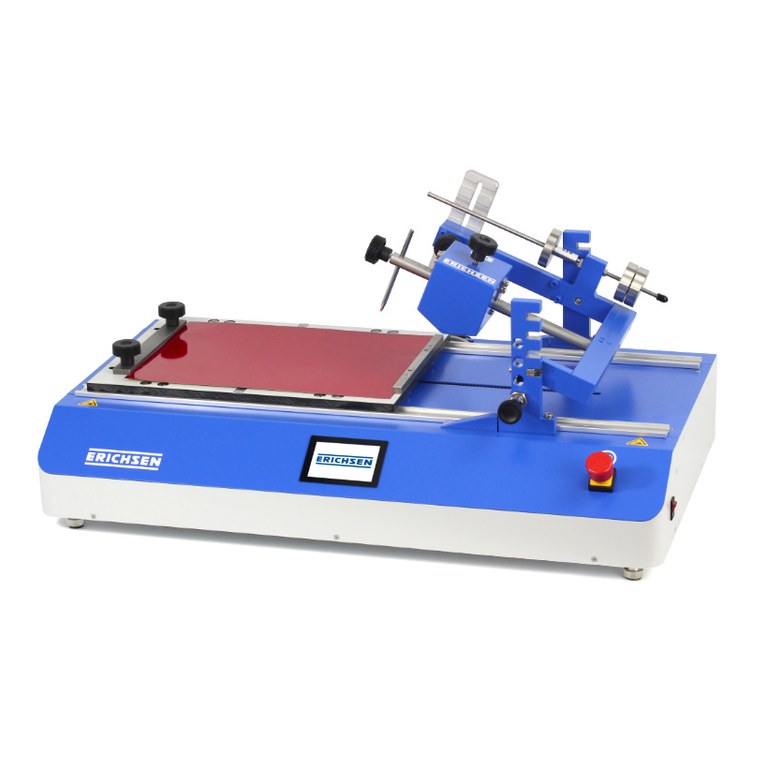
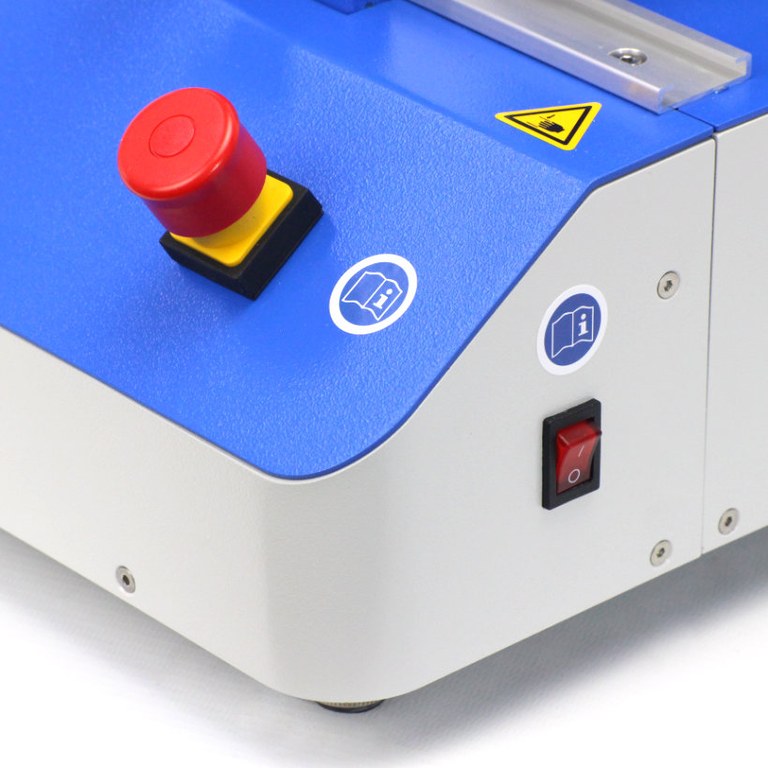
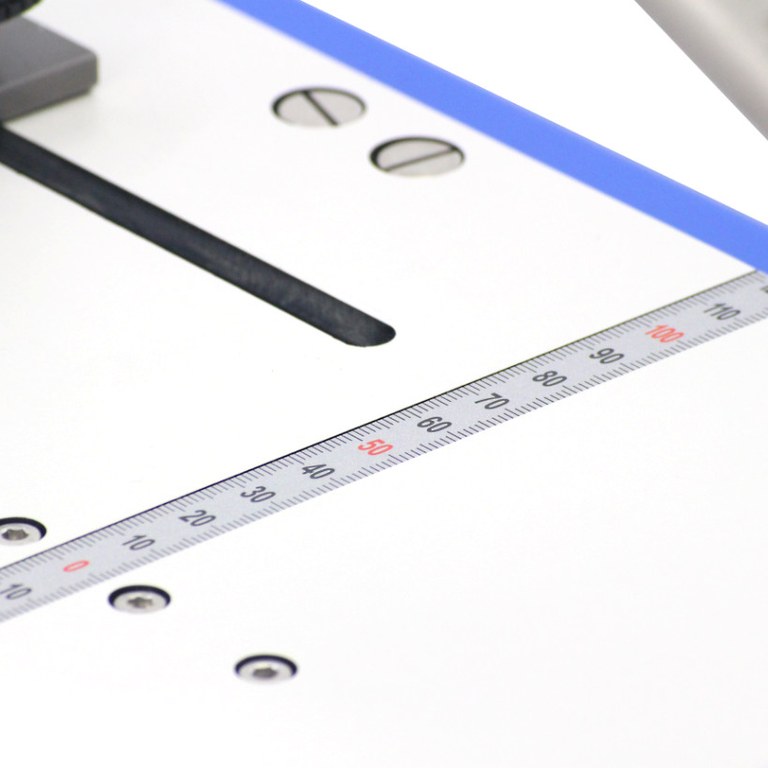
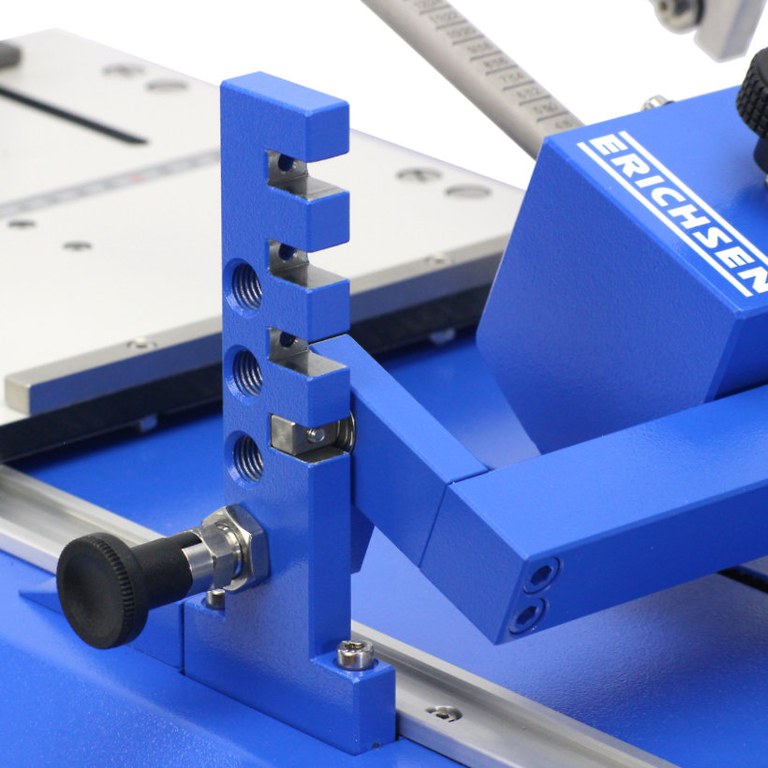
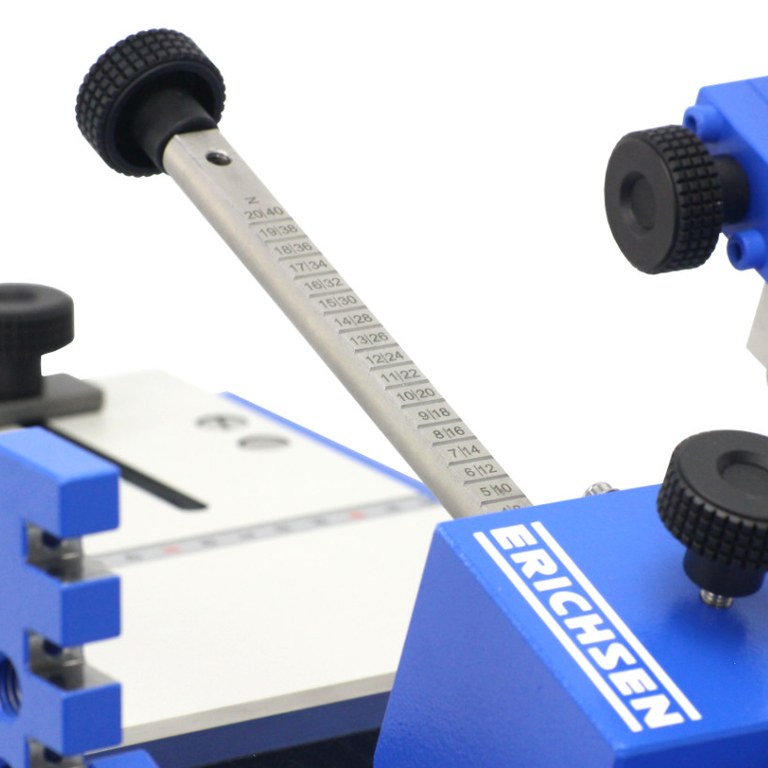
Scratch Hardness Tester LINEARTESTER 249 Smart XL
Order number: 30810131-
Non-Binding Inquiry
With the button below you can add products to your product inquiry list if you want us to do a quote for this product.
Note this product
Scratch Hardness Testing
Scratch Hardness Tester LINEARTESTER 249 Smart XL
The optimised scratch hardness tester LINEARTESTER 249 Smart XL is intended, in addition to its original purpose of application, i. e. to establish the ability of a surfaces to resist damage by scratching, also for several other tests: Scribe/Scratch tests; To and frocycle abrasion tests; Crockmeter tests; MEK tests; tests determining the resistance against solvents in general or wipe test, respectively.
The LINEARTESTER 249 Smart XL is a tabletop device that is operated via a capacitive LCD display. The electromotive drive ensures a uniform forward motion of the slide. The test tool is lowered and lifted automatically when scratch/scribe tests are carried out. A multitude of different test tools are available (see table in the technical description below). The tools marked with (*) are made of Tungsten Carbide Steel, additionally covered with an extremely hard layer. Due to this layer’s "golden" appearance, any worn parts are visually very easy recognizable because the Tungsten Carbide Material under the "golden" layer has a distincly different color. With the optional available universal adapter set (see last page of the technical description) even also several user-specifc tool inserts can be used.
Principle of the Test: The test panel is fixed onto a mobile slide by means of clamping rails. Above this slide and held on two metal pillars is a reciprocating beam bedded in a free-moving manner and carrying the adequate test tool as well as a
weight. The required scratching force in the range of (0.5 to 20)N is set by moving the weight along the reciprocating beam, making use of a setting scale (an additional load weight of (1 to 40)N is optionally available). The testing machine is equipped with a 4-position height adjustable load arm device with standard height of about 10 mm (+20/+40/+60 mm). To use the vertical adjustment, a set of sample clamping pieces are also required (Order No. 21010232). Operation (settings) is via a capacitive LCD display. To start a scratch/scribe test, the test tool is lowered onto the specimen when moving forward initiating the scratching process immediately. The test panel can be moved sideways so that a series of scratches can be carried out side by side with different force settings. Due to a ruler integrated in the slide plate, an uniform distance between the scratches can be achieved very easily. When testing insulating coatings on conducting substrates, an electric recognition of the through-scratching offers an additional security for setting the scratching force. For abrasion tests, crockmeter tests, MEK or wipe tests the test movement is carried out with the tool lowered onto the specimen, in preset cycles to and fro. For this, the guide plate has to be removed from the slide plate. The test speeds are freely adjustable. The LINEARTESTER Smart is equipped with variable stroke lengths.
Technical Descriptions
Norms
- ISO 1518
Technical specifications
Drive
Electric
Scratch profile
Van Laar, Bosch, ISO, Clemen, etc.
Testing Force
0.5-40 N
Portable / Stationary
Stationary
Dimensions (L x W x H)
approx. 680 x 380 x 325 mm
Specimen dimensions
210 x 260 mm
Test speed
Single stroke: (10 - 100)mm/s; double stroke: (10 - 400)mm/s infinitely adjustable
Test length
Single stroke: (50 - 220)mm
Stroke length
Double stroke (35 – 260)mm variably adjustable
Equipment
Order number: 21010332
- 491.00 €
- Non-Binding Inquiry
Price excl. VAT. We sell to professional buyers
With the button below you can add products to your product inquiry list if you want us to do a quote for this product.
Note this product
Order number: 31390132
Mehr lesen...
- 716.00 €
- Non-Binding Inquiry
Price excl. VAT. We sell to professional buyers
With the button below you can add products to your product inquiry list if you want us to do a quote for this product.
Note this product
Order number: 32990232
Mehr lesen...
- 945.00 €
- Non-Binding Inquiry
Price excl. VAT. We sell to professional buyers
With the button below you can add products to your product inquiry list if you want us to do a quote for this product.
Note this product
Order number: 04330132
- 268.00 €
- Non-Binding Inquiry
Price excl. VAT. We sell to professional buyers
With the button below you can add products to your product inquiry list if you want us to do a quote for this product.
Note this product
Order number: 04330232
- 268.00 €
- Non-Binding Inquiry
Price excl. VAT. We sell to professional buyers
With the button below you can add products to your product inquiry list if you want us to do a quote for this product.
Note this product
Order number: 04330732
- 368.00 €
- Non-Binding Inquiry
Price excl. VAT. We sell to professional buyers
With the button below you can add products to your product inquiry list if you want us to do a quote for this product.
Note this product
Order number: 19610232
- 345.00 €
- Non-Binding Inquiry
Price excl. VAT. We sell to professional buyers
With the button below you can add products to your product inquiry list if you want us to do a quote for this product.
Note this product
Order number: 915030241
- 247.00 €
- Non-Binding Inquiry
Price excl. VAT. We sell to professional buyers
With the button below you can add products to your product inquiry list if you want us to do a quote for this product.
Note this product
Order number: 06930132
- 247.00 €
- Non-Binding Inquiry
Price excl. VAT. We sell to professional buyers
With the button below you can add products to your product inquiry list if you want us to do a quote for this product.
Note this product
Order number: 08420132
- 354.00 €
- Non-Binding Inquiry
Price excl. VAT. We sell to professional buyers
With the button below you can add products to your product inquiry list if you want us to do a quote for this product.
Note this product
Order number: 02080232
- 269.00 €
- Non-Binding Inquiry
Price excl. VAT. We sell to professional buyers
With the button below you can add products to your product inquiry list if you want us to do a quote for this product.
Note this product
Order number: 915030441
- 785.00 €
- Non-Binding Inquiry
Price excl. VAT. We sell to professional buyers
With the button below you can add products to your product inquiry list if you want us to do a quote for this product.
Note this product
Order number: 07410132
- 386.00 €
- Non-Binding Inquiry
Price excl. VAT. We sell to professional buyers
With the button below you can add products to your product inquiry list if you want us to do a quote for this product.
Note this product
Order number: 07400132
- 192.00 €
- Non-Binding Inquiry
Price excl. VAT. We sell to professional buyers
With the button below you can add products to your product inquiry list if you want us to do a quote for this product.
Note this product
Order number: 08400132
Mehr lesen...
- 221.00 €
- Non-Binding Inquiry
Price excl. VAT. We sell to professional buyers
With the button below you can add products to your product inquiry list if you want us to do a quote for this product.
Note this product
Order number: 08410132
- 89.00 €
- Non-Binding Inquiry
Price excl. VAT. We sell to professional buyers
With the button below you can add products to your product inquiry list if you want us to do a quote for this product.
Note this product
Order number: 08490132
Mehr lesen...
- 101.00 €
- Non-Binding Inquiry
Price excl. VAT. We sell to professional buyers
With the button below you can add products to your product inquiry list if you want us to do a quote for this product.
Note this product
Order number: 19100132
- 474.00 €
- Non-Binding Inquiry
Price excl. VAT. We sell to professional buyers
With the button below you can add products to your product inquiry list if you want us to do a quote for this product.
Note this product
Order number: 03640853
- 77.00 €
- Non-Binding Inquiry
Price excl. VAT. We sell to professional buyers
With the button below you can add products to your product inquiry list if you want us to do a quote for this product.
Note this product
Order number: 03644752
- 37.00 €
- Non-Binding Inquiry
Price excl. VAT. We sell to professional buyers
With the button below you can add products to your product inquiry list if you want us to do a quote for this product.
Note this product
Order number: 06900132
- 402.00 €
- Non-Binding Inquiry
Price excl. VAT. We sell to professional buyers
With the button below you can add products to your product inquiry list if you want us to do a quote for this product.
Note this product
Order number: 05390132
- 247.00 €
- Non-Binding Inquiry
Price excl. VAT. We sell to professional buyers
With the button below you can add products to your product inquiry list if you want us to do a quote for this product.
Note this product
Order number: 05390232
- 221.00 €
- Non-Binding Inquiry
Price excl. VAT. We sell to professional buyers
With the button below you can add products to your product inquiry list if you want us to do a quote for this product.
Note this product
Order number: 05390332
Mehr lesen...
- 242.00 €
- Non-Binding Inquiry
Price excl. VAT. We sell to professional buyers
With the button below you can add products to your product inquiry list if you want us to do a quote for this product.
Note this product
Order number: 05390732
Mehr lesen...
- 509.00 €
- Non-Binding Inquiry
Price excl. VAT. We sell to professional buyers
With the button below you can add products to your product inquiry list if you want us to do a quote for this product.
Note this product
Order number: 05390432
- 234.00 €
- Non-Binding Inquiry
Price excl. VAT. We sell to professional buyers
With the button below you can add products to your product inquiry list if you want us to do a quote for this product.
Note this product
Order number: 02180232
- 286.00 €
- Non-Binding Inquiry
Price excl. VAT. We sell to professional buyers
With the button below you can add products to your product inquiry list if you want us to do a quote for this product.
Note this product
Order number: 05640132
- 497.00 €
- Non-Binding Inquiry
Price excl. VAT. We sell to professional buyers
With the button below you can add products to your product inquiry list if you want us to do a quote for this product.
Note this product
Order number: 05391332
- 778.00 €
- Non-Binding Inquiry
Price excl. VAT. We sell to professional buyers
With the button below you can add products to your product inquiry list if you want us to do a quote for this product.
Note this product
Order number: 04300132
- 57.00 €
- Non-Binding Inquiry
Price excl. VAT. We sell to professional buyers
With the button below you can add products to your product inquiry list if you want us to do a quote for this product.
Note this product
Order number: 04300232
- 57.00 €
- Non-Binding Inquiry
Price excl. VAT. We sell to professional buyers
With the button below you can add products to your product inquiry list if you want us to do a quote for this product.
Note this product
Order number: 04300332
- 57.00 €
- Non-Binding Inquiry
Price excl. VAT. We sell to professional buyers
With the button below you can add products to your product inquiry list if you want us to do a quote for this product.
Note this product
Order number: 04300432
- 85.00 €
- Non-Binding Inquiry
Price excl. VAT. We sell to professional buyers
With the button below you can add products to your product inquiry list if you want us to do a quote for this product.
Note this product
Order number: 08440132
- 108.00 €
- Non-Binding Inquiry
Price excl. VAT. We sell to professional buyers
With the button below you can add products to your product inquiry list if you want us to do a quote for this product.
Note this product
Order number: 08450132
- 108.00 €
- Non-Binding Inquiry
Price excl. VAT. We sell to professional buyers
With the button below you can add products to your product inquiry list if you want us to do a quote for this product.
Note this product



































